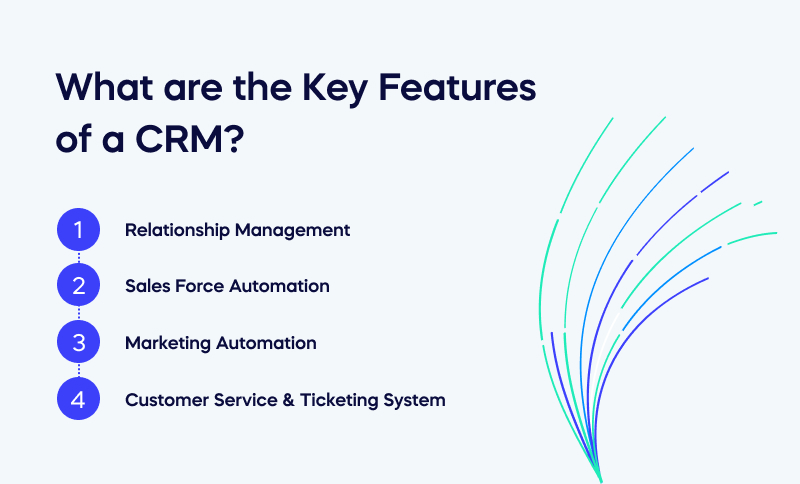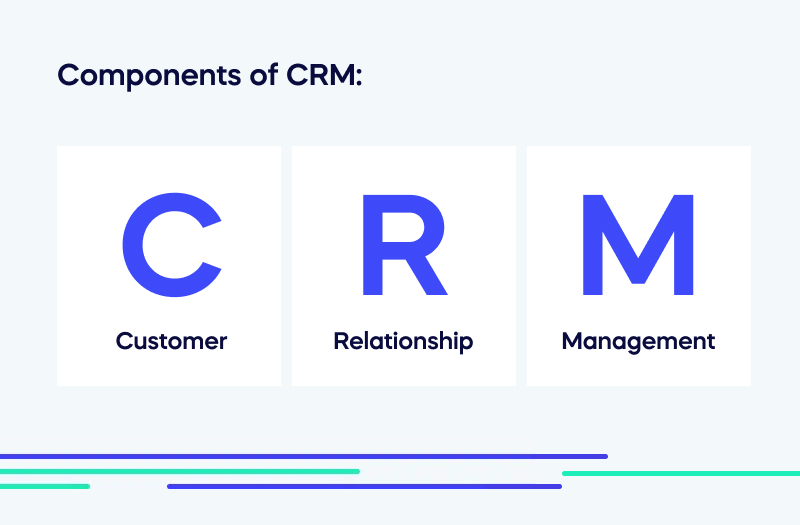
The meaning of the CRM acronym

CRM stands for “Customer Relationship Management”. It refers to a strategy, process, or technology used by businesses to manage and analyze interactions with their customers and potential customers. The main goal of CRM is to improve customer satisfaction and retention by better understanding their needs and providing more personalized and targeted services or products. It involves collecting and analyzing customer data, tracking customer interactions, and automating sales and marketing processes. Overall, CRM helps businesses to build stronger, long-lasting relationships with their customers, and ultimately increase profitability.
What are the Key Features of a CRM?

CRM is a powerful tool that can help organizations improve customer relationships, increase sales, and streamline operations. With its advanced features and functionality, CRM has become an essential tool for businesses of all sizes and industries. The key features of CRM include:
Relationship Management
In CRM, relationship management refers to the processes, strategies, and tools used by businesses to build, maintain, and improve their relationships with customers. It involves managing interactions with customers across multiple touchpoints, such as email, phone, social media, and in-person interactions.
Relationship management in CRM focuses on understanding customers’ needs, preferences, and behaviors, and providing them with personalized services or products to meet their expectations. It involves collecting and analyzing customer data, tracking customer interactions, and providing relevant information and offers to customers based on their individual profiles.
Effective relationship management in CRM helps businesses to build stronger and more meaningful relationships with their customers, leading to increased customer loyalty and retention. It also enables businesses to identify opportunities for upselling and cross-selling, and to provide more efficient and effective customer service.
Sales Force Automation
Sales force automation (SFA) is a feature of CRM that automates and streamlines sales processes to improve the efficiency and effectiveness of sales teams. SFA involves using technology to automate sales tasks such as lead management, contact management, sales forecasting, pipeline management, and order processing.
With SFA, sales teams can easily manage and track customer interactions, create and manage sales proposals, automate sales reporting, and identify potential sales opportunities. This helps businesses to improve the overall productivity and efficiency of their sales teams, and ultimately increase revenue.
SFA also enables businesses to provide better customer service by ensuring that sales representatives have access to up-to-date and relevant customer data, allowing them to provide more personalized service to customers. By automating routine sales tasks, SFA also frees up sales representatives’ time to focus on higher-value activities, such as building relationships with customers and identifying new sales opportunities. Overall, SFA is an important aspect of CRM that helps businesses to improve sales efficiency and effectiveness, and better serve their customers.
Marketing Automation
Marketing automation is a feature of CRM that automates and streamlines marketing processes to improve the efficiency and effectiveness of marketing campaigns. It involves using technology to automate repetitive marketing tasks such as email marketing, social media marketing, lead generation, lead scoring, and lead nurturing.
With marketing automation, businesses can create and manage targeted marketing campaigns that are tailored to individual customers based on their behavior and preferences. This helps to improve the relevance and effectiveness of marketing campaigns, leading to increased customer engagement and ultimately higher conversion rates.
Marketing automation also enables businesses to track and analyze customer behavior and preferences, allowing them to make data-driven marketing decisions. This helps to improve the accuracy of marketing campaigns and ensures that businesses are targeting the right customers with the right messages at the right time.
Overall, marketing automation is an important aspect of CRM that helps businesses to improve the efficiency and effectiveness of marketing campaigns, better understand their customers, and ultimately increase revenue.
Customer Service & Ticketing System
Customer Service & Ticketing System is a feature of CRM that allows businesses to manage customer inquiries, issues, and complaints in a more efficient and organized way. It involves using technology to automate the process of capturing, tracking, and resolving customer service issues.
With Customer Service & Ticketing System, businesses can easily manage customer inquiries through a centralized system, which tracks all customer interactions, including emails, phone calls, chat messages, and social media interactions. This helps to ensure that customer inquiries are handled promptly and efficiently, and that no inquiries are missed.
The ticketing system allows businesses to assign a unique reference number to each customer inquiry, which can be used to track the status of the inquiry and ensure that it is resolved in a timely manner. Businesses can also use the system to prioritize and assign inquiries to the appropriate team members based on the nature of the inquiry and the expertise of the team member.
Customer Service & Ticketing System also provides businesses with valuable data and insights on customer inquiries and issues, allowing them to identify trends and patterns in customer behavior and take steps to address these issues proactively.
Overall, Customer Service & Ticketing System is an important aspect of CRM that helps businesses to improve the quality and efficiency of customer service, leading to higher customer satisfaction and loyalty.
Understanding the origin and history of the CRM acronym
From contact management which was a simple system to customer management where the main focus is employee productivity and customer satisfaction, the tool has evolved and grown successfully to an advanced and automated CRM software. Years back, contact management was used to keep track of basic information like contact number, address, appointments, etc. And then with time, a few more features were added to the system such as sales feature to automate sales processes, then marketing campaigns and customer support were later included. And these additions that revolved around a businesses relationship with the customer and the name progressed to be Customer Relationship Management (CRM).
Components of CRM: Explaining the meaning of the individual letters (C, R, M)

The three components of CRM, which are often referred to as the “C,” “R,” and “M” of CRM, stand for:
Customer – The “C” in CRM stands for Customer, which refers to the organization’s target audience, including existing and potential customers. In CRM, the customer is at the center of all activities, and the goal is to build strong relationships with them through personalized experiences, excellent service, and meaningful interactions.
Relationship – The “R” in CRM stands for Relationship, which refers to the interactions and engagements between the organization and its customers. The goal of relationship management is to build trust, loyalty, and long-term relationships with customers, which can help to improve customer retention and increase customer lifetime value.
Management – The “M” in CRM stands for Management, which refers to the tools and processes used to manage customer relationships effectively. This includes everything from managing customer data and tracking customer interactions to managing customer service requests and analyzing customer behavior to gain insights.
Together, these three components form the foundation of CRM, and they are essential for building strong customer relationships and improving the overall customer experience. By focusing on the customer, building meaningful relationships, and leveraging effective management tools and processes, organizations can improve their customer retention rates, increase sales, and achieve their business goals.
Future outlook for CRM
The future outlook for Customer Relationship Management (CRM) is promising, as technology continues to evolve, and customer expectations continue to increase. Here are some of the key trends that are likely to shape the future of CRM:
Artificial Intelligence (AI) and Machine Learning (ML): AI and ML technologies are already being used in CRM to automate routine tasks, personalize customer interactions, and provide real-time insights. In the future, we can expect to see even more advanced AI and ML solutions that can anticipate customer needs, provide proactive recommendations, and automate complex tasks.
Omnichannel engagement: Customers now expect to engage with brands across multiple channels, including email, social media, messaging apps, and more. The future of CRM will focus on delivering a seamless, omnichannel experience that allows customers to interact with brands on their terms.
Personalization: Customers expect personalized experiences, and the future of CRM will rely heavily on data analytics to provide personalized recommendations, targeted marketing, and tailored interactions based on customer preferences and behavior.
Customer self-service: Customers increasingly prefer to solve problems and answer questions on their own, without having to interact with a customer service representative. The future of CRM will include advanced self-service options, such as chatbots, virtual assistants, and knowledge bases, to help customers find the information they need quickly and easily.
Internet of Things (IoT): With the rise of IoT, we can expect to see more devices and sensors that can collect data on customer behavior and preferences. The future of CRM will involve leveraging this data to provide even more personalized and proactive customer experiences.
Overall, the future of CRM is bright, as technology continues to advance, and customer expectations continue to evolve. By embracing new technologies and trends, and focusing on delivering exceptional customer experiences, organizations can stay ahead of the curve and achieve their business goals.

